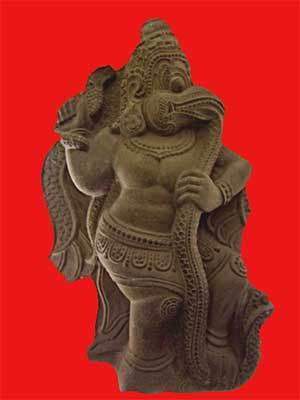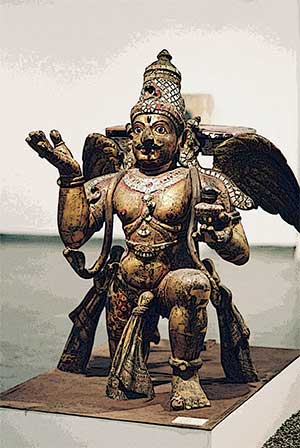
Garuda - The Vahana of Lord Vishnu

Recently there was a television program on ancient aliens, and one of the episodes described Garuda as a spaceship and Vishnu as an alien Lord. It is not true. No ancient aliens visited India and established the Vedic culture. It was a religious tradition whose roots are in the Vedas. The gods are heavenly gods, not aliens. There may be aliens in some part of the universe, but they are not responsible for the religious traditions and beliefs of Hinduism.
There are many subtle words, made of prana and subtle matter. Our gods belong to those worlds and they reside in those spheres. We can communicate with them through our own consciousness, but it requires huge effort and a lot of self-purification. If your mind is silent and pure, you can see our gods in those spheres, and even communicate with them. They usually do not interfere with our lives, unless it is extremely necessary and important for the cause of creation.

Garuda or Garutmanta, is the eagle like divine bird used by Lord Vishnu as his vehicle. He is not an ordinary bird and you can imagine his size since he serves as the vehicle of Vishnu, who is preserver and the lord of the Universe.
According to the Puranas, Garuda was the son of sage Kashyapa and Vinata. According to the legends, Vinata has a sister named Kadru. She is the mother of snakes. Once, Kadru captured Vinata due to a personal rivalry and held her captive. She insisted that if Garuda brought her the ambrosia (amrit) from the heavens, she would free her.
To save his mother, Garuda went to heaven, killed two serpents who were guarding the pot of ambrosia and brought it to Kadru. His mother was released. However, Indra, the Lord of the heavens, was not pleased with these developments. He insisted on Garuda to bring the pot of ambrosia back to heaven and in return gave permission to Garuda to kill and eat the snakes. Since that day, Garuda has begun feeding upon snakes.
In the iconography Garuda is depicted with a strong human body and an eagle like face. He holds two snakes in his two hands, wears several snakes as ornaments on his body, as belt around girdle, sacred thread, necklace and rings. He is also depicted in many images either with folded hands or carrying a pot of ambrosia either with one or two of his hands. Sometimes he is shown as devouring serpents. In some images, he is flanked on both sides by his two consorts, Rudra and Sukriti. Symbolically, Garuda represents the moving aspect of creation, namely breath in the microcosm and wind in the macrocosm.
Garuda's birth and his exploits in heaven to secure the ambrosia are mentioned in the Mahabharata. According to the epic, Garuda has six sons, who are the progenitors of the entire bird community. Garuda served as the vehicle to Lord Krishna and Satyabhama in their war with Narakasura, the demon who is mentioned in the legends associated with the origin of the festival of Dipawali.
Suggestions for Further Reading
- Symbolism Of The Vehicles of Hindu Gods and Goddesses
- Navagrahas, the Nine Planetary gods in Hinduism
- Hinduism - Gods and Goddess in the Vedas
- Gods and Goddesses of Hinduism
- Hindu God Lord Shiva (Siva) - the Destroyer
- Hindu God Vishnu, the Preserver
- Hindu Temples and Sacred Places of Worship
- The Concept of Atman or Eternal Soul in Hinduism
- The Problem of Maya Or Illusion and How To Deal With It
- Belief In Atman, The Eternal Soul Or The Inner Self
- Brahman, The Highest God Of Hinduism
- The Bhagavad Gita Original Translations
- The Bhagavadgita, Philosophy and Concepts
- Bhakti yoga or the Yoga of Devotion
- Hinduism And The Evolution of Life And Consciousness
- Why to Study the Bhagavadgita Parts 1 to 4
- Origin, Definition and Introduction to Hinduism
- Symbolic Significance of Numbers in Hinduism
- The Belief of Reincarnation of Soul in Hinduism
- The True Meaning Of Renunciation According To Hinduism
- The Symbolic Significance of Puja Or Worship In Hinduism
- Introduction to the Upanishads of Hinduism
- Origin, Principles, Practice and Types of Yoga
- Essays On Dharma
- Esoteric Mystic Hinduism
- Introduction to Hinduism
- Hindu Way of Life
- Essays On Karma
- Hindu Rites and Rituals
- The Origin of The Sanskrit Language
- Symbolism in Hinduism
- Essays on The Upanishads
- Concepts of Hinduism
- Essays on Atman
- Hindu Festivals
- Spiritual Practice
- Right Living
- Yoga of Sorrow
- Happiness
- Mental Health
- Concepts of Buddhism
- General Essays
Attribution: The images of Garuda used in this article are licensed under the Creative Commons Attribution-Share Alike 2.0 Generic license. The article is copyright Hinduwebsite.com